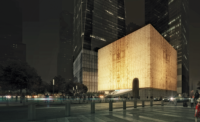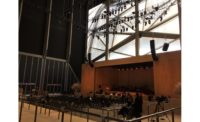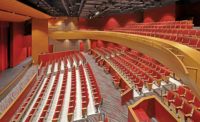It took some fancy footwork to create the marble-clad Perelman Performing Arts Center at the World Trade Center in Lower Manhattan—a deceptively simple cube, only 160 ft square and 117 ft tall, that sits to the north of the reflecting pools at the 9/11 Memorial and Museum.
Constructing the venue's three reconfigurable theaters has been compared to building three ships in a bottle. Readying the myriad parts of the "ships" for the first public performance on Sept. 19 has been likened to fine-tuning a Swiss watch—while someone is wearing it.
Throughout the summer, construction manager Sciame Construction had to work parallel paths—completing building and getting it ready to open by testing acoustics and theater configurations, Joseph Mizzi, firm president and chief operating officer, said in an email. The company had to do this in between soft-opening performances and other public events happening each weekend in August and September.

In this configuration, two theaters are combined into one for a traditional large theater set-up.
Photo by Nadine M. Post/ENR
PAC NYC is on land—and atop World Trade Center mechanical systems—that are owned by the Port Authority of New York and New Jersey. It sits on a 21-ft-tall plinth clad in black granite, interrupted by a grand entry staircase.
The theater’s three reconfigurable halls can remain separate or be combined into one or two halls. More than 60 stage and seating set-ups are possible, thanks to movable feats that include 46-ton walls—called guillotine doors—that rise into mechanical space above the ceiling and disappear, a performance hall floor on lifts, rolling seating towers and removable seats.
“A theater is a complex animal,” says Joshua Ramus, founding principal of REX, which designed the eight-story theater in collaboration with executive architect Davis Brody Bond and theater consultant Charcoalblue. “A reconfigurable theater increases that complexity,” he adds.

REX’s Joshua Ramus (center) designed the building to be a subtle backdrop to the 9/11 memorial during the day and a glowing golden beacon at night.
Photo by Nadine M. Post/ENR
The reconfigurability of spaces meant that there were multiple setups of theater equipment, lights, speakers, decking, seats, rails and more. They all needed to be built to test and punch-list different setups, says Mizzi. "Punch-list items needed to be addressed on a tight schedule because each configuration would be dismantled only days later," he adds.
While the theater spaces continued to be commissioned and changed, crews were putting the finishing touches on mechanical-system balancing, fire-alarm testing, flooring and painting throughout the building.
Life safety system sign-off was another challenge, Mizzi says. This included fire alarm, sprinkler, stair pressurization, elevators, emergency egress and emergency lighting sign-offs, as well as integration of the systems with the Port Authority's systems, below grade.
Major funding for the $500-million venue includes $130 million from former Mayor Michael R. Bloomberg—PAC NYC board chair; $100-million from the federal government via the Lower Manhattan Development Corp.; and $75 million from financier Ronald O. Perelman.

During the day, sunlight streams through the translucent veined marble to light up the corridor that wraps the building on four sides.
Photo by Nadine M. Post/ENR
The Port Authority only gave structural engineer Magnusson Klemencic Associates seven points to transfer loads from the theater to foundations, mostly outside the footprint that was installed nearly two decades ago for an earlier performance venue that was never realized. That meant that more than 60% of the PAC NYC footprint could not have a column. The structural engineer pushed most of the columns to the edges and reverse engineered the building from the bottom up.
During a Sept. 13 "ribbon-threading" to inaugurate the building, also attendeed by New York State Gov. Kathy Hochul and New York City Mayor Eric L. Adams, Bloomberg thanked the project's engineers, who "made sure the vibrations" and noise from 13 trains and myriad delivery trucks that rumble under the building won't interfere with the performances.
The former mayor also gave a shoutout to REX's Ramus, who designed the light cream-colored cube to be a subtle backdrop to the sober 9/11 Memorial during the day. He had a completely different goal for the cube at night, when the memorial is cordoned off. Lit from within, PAC NYC becomes a hopeful golden beacon—a symbol of New Yorkers' resilience after 9/11 and a civic and cultural attraction in the city.






Post a comment to this article
Report Abusive Comment